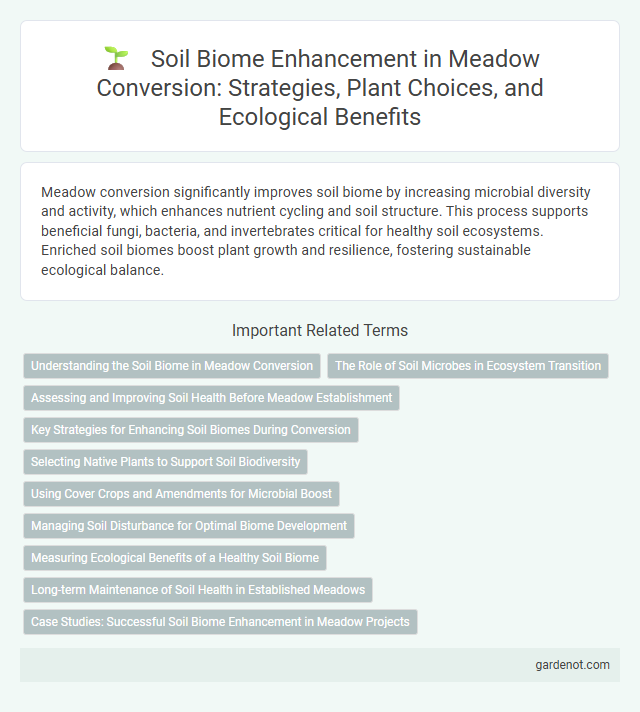Meadow conversion significantly improves soil biome by increasing microbial diversity and activity, which enhances nutrient cycling and soil structure. This process supports beneficial fungi, bacteria, and invertebrates critical for healthy soil ecosystems. Enriched soil biomes boost plant growth and resilience, fostering sustainable ecological balance.
Understanding the Soil Biome in Meadow Conversion
Understanding the soil biome in meadow conversion is vital for promoting biodiversity and ecosystem resilience. Diverse microbial communities, including bacteria, fungi, and invertebrates, drive nutrient cycling and enhance soil structure, supporting plant growth. Maintaining a healthy soil biome boosts carbon sequestration and water retention, crucial for long-term meadow sustainability.
The Role of Soil Microbes in Ecosystem Transition
Soil microbes play a critical role in meadow conversion by accelerating nutrient cycling and improving soil structure, which enhances overall soil fertility and promotes plant growth. These microorganisms facilitate the breakdown of organic matter, increasing the availability of essential nutrients such as nitrogen and phosphorus, vital for supporting diverse meadow plant communities. Their activity helps stabilize soil carbon, contributing to long-term ecosystem resilience and successful transition from other land uses to stable meadow biomes.
Assessing and Improving Soil Health Before Meadow Establishment
Assessing soil health before meadow establishment involves analyzing soil texture, organic matter content, pH levels, and microbial activity to determine nutrient availability and structure quality. Improving soil biome can be achieved through adding organic amendments, implementing cover cropping, and reducing soil compaction to enhance aeration and water retention. These practices promote beneficial microbial populations and create a sustainable growing environment for native meadow species.
Key Strategies for Enhancing Soil Biomes During Conversion
Key strategies for enhancing soil biomes during meadow conversion include incorporating organic matter such as compost and mulch to increase microbial activity and nutrient availability. Implementing crop rotation and cover cropping with native plants promotes biodiversity and improves soil structure, aiding water retention and root penetration. Avoiding chemical fertilizers and pesticides preserves beneficial soil organisms, fostering a balanced and resilient soil ecosystem essential for sustaining meadow growth.
Selecting Native Plants to Support Soil Biodiversity
Selecting native plants for meadow conversion significantly enhances soil biodiversity by promoting a diverse microbial community and improving nutrient cycling. Deep-rooted native species increase soil aeration and organic matter content, fostering resilient soil ecosystems. This biodiversity boost supports essential soil functions, such as water retention and disease suppression, creating a sustainable biome foundation.
Using Cover Crops and Amendments for Microbial Boost
Using cover crops such as clover and vetch enriches soil biome by increasing organic matter and promoting microbial diversity in meadow conversion projects. Incorporating organic amendments like compost and biochar enhances nutrient availability and supports beneficial microbial activity, improving soil structure and plant health. These practices accelerate soil regeneration, boosting microbial biomass and fostering a resilient ecosystem for sustainable meadow growth.
Managing Soil Disturbance for Optimal Biome Development
Managing soil disturbance in meadow conversion is crucial to promoting a healthy soil biome, as minimal disruption preserves microbial communities and nutrient cycling. Techniques such as reduced tillage and controlled grazing support soil structure integrity and enhance organic matter content. These practices optimize conditions for beneficial organisms, improving soil fertility and ecosystem resilience.
Measuring Ecological Benefits of a Healthy Soil Biome
Measuring the ecological benefits of a healthy soil biome in meadow conversion involves assessing increased soil organic matter, enhanced microbial diversity, and improved nutrient cycling efficiency. These factors contribute to higher soil fertility, greater water retention, and increased carbon sequestration, which support sustainable plant growth and biodiversity. Quantitative data from soil respiration rates and microbial biomass provide critical indicators for evaluating soil biome health and its positive environmental impact.
Long-term Maintenance of Soil Health in Established Meadows
Long-term maintenance of soil health in established meadows relies on promoting diverse microbial communities that enhance nutrient cycling and organic matter decomposition. Regular monitoring of soil pH, moisture levels, and nutrient content supports sustained biome functionality and prevents degradation. Integrating native plant species with deep root systems improves soil structure and fosters resilience against erosion and compaction over time.
Case Studies: Successful Soil Biome Enhancement in Meadow Projects
Case studies on meadow projects highlight significant soil biome enhancement through diverse native plant integration, which boosts microbial diversity and nutrient cycling. In one project, introducing deep-rooted grasses increased organic matter by 40%, improving soil structure and water retention. These outcomes demonstrate the critical role of tailored seed mixes and adaptive management in restoring soil health and ecosystem resilience in meadow conversions.
Soil biome enhancement Infographic

 gardenot.com
gardenot.com